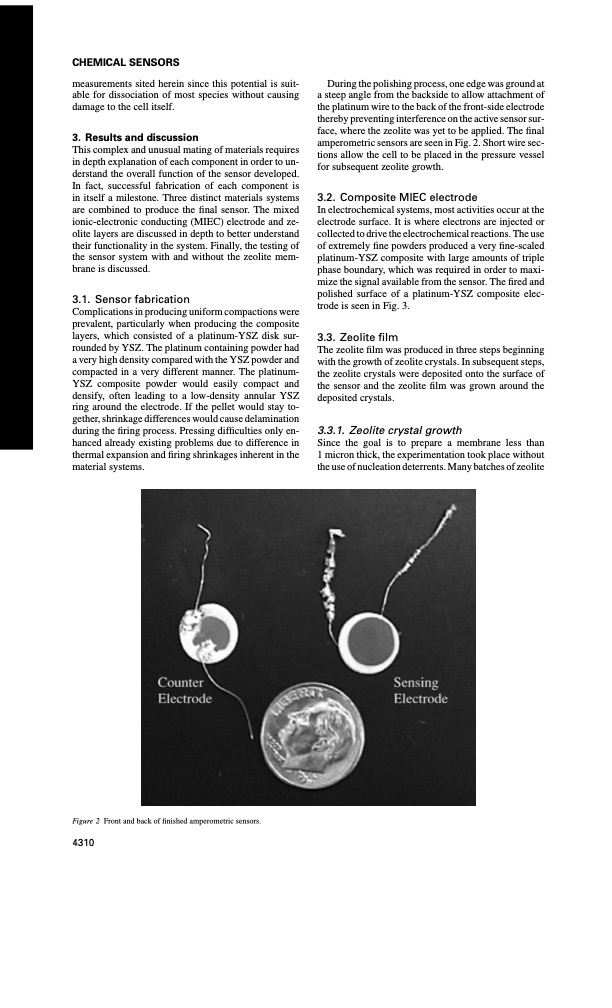
PDF Publication Title:
Text from PDF Page: 004
CHEMICAL SENSORS measurements sited herein since this potential is suit- able for dissociation of most species without causing damage to the cell itself. 3. Results and discussion This complex and unusual mating of materials requires in depth explanation of each component in order to un- derstand the overall function of the sensor developed. In fact, successful fabrication of each component is in itself a milestone. Three distinct materials systems are combined to produce the final sensor. The mixed ionic-electronic conducting (MIEC) electrode and ze- olite layers are discussed in depth to better understand their functionality in the system. Finally, the testing of the sensor system with and without the zeolite mem- brane is discussed. 3.1. Sensor fabrication Complications in producing uniform compactions were prevalent, particularly when producing the composite layers, which consisted of a platinum-YSZ disk sur- rounded by YSZ. The platinum containing powder had a very high density compared with the YSZ powder and compacted in a very different manner. The platinum- YSZ composite powder would easily compact and densify, often leading to a low-density annular YSZ ring around the electrode. If the pellet would stay to- gether, shrinkage differences would cause delamination during the firing process. Pressing difficulties only en- hanced already existing problems due to difference in thermal expansion and firing shrinkages inherent in the material systems. During the polishing process, one edge was ground at a steep angle from the backside to allow attachment of the platinum wire to the back of the front-side electrode thereby preventing interference on the active sensor sur- face, where the zeolite was yet to be applied. The final amperometric sensors are seen in Fig. 2. Short wire sec- tions allow the cell to be placed in the pressure vessel for subsequent zeolite growth. 3.2. Composite MIEC electrode In electrochemical systems, most activities occur at the electrode surface. It is where electrons are injected or collected to drive the electrochemical reactions. The use of extremely fine powders produced a very fine-scaled platinum-YSZ composite with large amounts of triple phase boundary, which was required in order to maxi- mize the signal available from the sensor. The fired and polished surface of a platinum-YSZ composite elec- trode is seen in Fig. 3. 3.3. Zeolite film The zeolite film was produced in three steps beginning with the growth of zeolite crystals. In subsequent steps, the zeolite crystals were deposited onto the surface of the sensor and the zeolite film was grown around the deposited crystals. 3.3.1. Zeolite crystal growth Since the goal is to prepare a membrane less than 1 micron thick, the experimentation took place without the use of nucleation deterrents. Many batches of zeolite Figure 2 Front and back of finished amperometric sensors. 4310PDF Image | Development of a selective gas sensor utilizing zeolite membrane

PDF Search Title:
Development of a selective gas sensor utilizing zeolite membraneOriginal File Name Searched:
2003-79-J-Mat-Sci-Rauch.pdfDIY PDF Search: Google It | Yahoo | Bing
CO2 Organic Rankine Cycle Experimenter Platform The supercritical CO2 phase change system is both a heat pump and organic rankine cycle which can be used for those purposes and as a supercritical extractor for advanced subcritical and supercritical extraction technology. Uses include producing nanoparticles, precious metal CO2 extraction, lithium battery recycling, and other applications... More Info
Heat Pumps CO2 ORC Heat Pump System Platform More Info
| CONTACT TEL: 608-238-6001 Email: greg@infinityturbine.com | RSS | AMP |